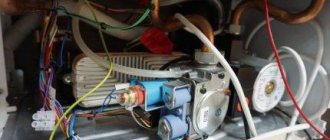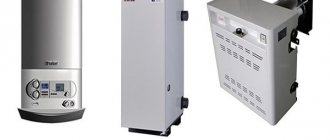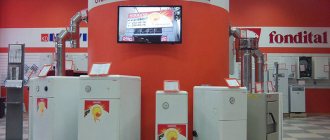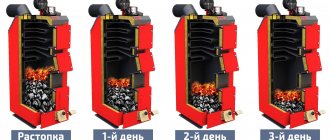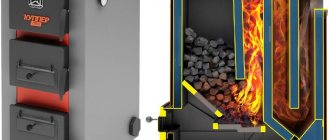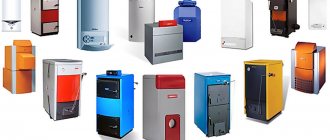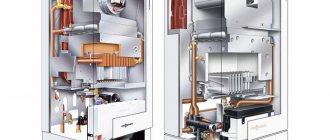The comfort and air temperature in the room depend on how efficiently the heating device operates. Many owners of private houses opt for floor-standing gas boilers. Such systems are durable and easy to use. They are capable of heating both small rooms and industrial buildings.
Advantages of floor-standing gas boilers
Floor-standing units running on gas have a number of advantages and are in many ways superior to other heating systems.
Among their advantages it is worth highlighting:
- Good efficiency. The latest technological techniques are used to assemble combustion chambers, which allow efficient use of fuel and more heat from it. Thanks to this, such heaters can boast high performance.
- Economical. An automated control system controls gas consumption.
- Ability to heat large rooms.
- Connection of additional elements and sensors for temperature control is available. Thus, the house can be provided with a comfortable microclimate.
- Durability and performance (even without regular maintenance).
- Ease of installation, maintenance and repair. Many modern models are equipped with a diagnostic system that independently finds faults and notifies the owner about them.
- Small size and low noise level.
- Environmental friendliness. The emissions of harmful substances into the atmosphere are close to zero.
- The built-in control system ensures safe use of the boiler.
- Many operating modes. A wide range of adjustable temperatures makes operation of the boiler simple and comfortable.
- Non-volatile models are not afraid of power outages.
- Low price of Russian gas (floor-standing) heating boilers.
Power calculation
When choosing a model that suits the user’s goals and objectives, it is important to correctly calculate the required equipment power. It is strongly recommended to do this with the help of a competent specialist, since in addition to the basic parameters, it is necessary to take into account many others that are not obvious to users, but are known to professionals.
Attention!
Without taking into account all the nuances, the required power may be calculated incorrectly, which will entail many problems, ranging from uncomfortable heating and temperature conditions to equipment failure.
The basic parameters on the basis of which power is calculated include:
- total area of the entire building;
- the area of each individual room that is planned to be heated;
- number of door and other openings;
- wall thickness and materials;
- quality and level of thermal insulation;
- climatic zone in which the house is located;
- planned engineering arrangement of the heating and hot water supply system;
- the presence or absence of drafts in the house;
- quality of windows and entrance doors.
Principle of operation
Such devices are an important component of the heating system, because they are responsible for generating heat. Devices operating on gas are considered very convenient, as they are technologically advanced and easy to use.
It is recommended to install such units only in those areas where it is possible to connect to the gas main. Kindling with liquefied gas will not allow the unit to achieve its maximum efficiency and will cost a pretty penny.
Devices of this type consist of three main parts:
- mechanism regulating fuel supply;
- gas burner;
- heat exchanger.
In addition, floor-standing devices are equipped with protection modules, diagnostics, electronic control, as well as safety valves and pumps that ensure water circulation. These heaters are often called mini-boiler rooms due to a similar operating principle and multi-element design.
The automatic system of the unit is guided by the readings of sensors and thermostats, after which the level of heat that the system needs is recorded. Then the operation of the gas fittings starts, and the liquid, which plays the role of a coolant, is heated to the required temperature and, thanks to the circulation pump, moves into the heating circuit.
Prices for floor-standing gas boilers
floor standing gas boilers
Pump
Pump in a gas boiler
Serves to impart movement to the coolant. This device causes heating fluid to circulate from the heated primary heat exchanger to the radiators, heat them and move back to heat them. The pump usually has several speeds and is adjusted by a service engineer based on the size of your heating system.
Too high a pump speed can create additional noise and reduce the efficiency of the boiler. And too small will lead to uneven heating of the radiators. Therefore, for proper setup, it is very important to contact qualified service engineers.
Types of gas floor boilers
Floor-standing units may have different combustion chambers - open or closed. They differ from each other in design and in the way they absorb air to maintain the flame.
With open combustion chamber
It is preferable to place open boilers in boiler rooms rather than in residential premises. These chambers work on the principle of sucking oxygen out of the room, which can negatively affect air quality. Therefore, the house will have to be regularly ventilated, and to remove combustion products, you will need to equip the device with a chimney with a powerful draft.
The main advantage of such options is their low cost, otherwise they are inferior to closed models.
With closed
Closed-type devices do not have special requirements for ventilation and smoke removal systems. To operate, they use air drawn in from the street, and soot and soot are regularly removed from the combustion chamber. When waste raw materials are released, all combustion products are cooled, which makes the use of such models practical and safe. The room is heated without air pollution, because all processes of converting gas into heat take place outside the house. Therefore, the operation of floor-standing boilers with a closed gas chamber is much more comfortable than with an open one.
These options are equipped with a coaxial chimney, which makes them energy-dependent, since the pumping unit is powered by electricity.
Requirements for a separate room in which the unit is planned to be placed
The choice of premises for organizing a home mini boiler room should also be approached responsibly. You cannot place the boiler in the first closet you come across. For optimal, efficient and safe operation of gas equipment, it must be installed in premises suitable for such purposes.
Spaces that are suitable for these purposes include rooms with the following parameters:
- the area of the home boiler room must be at least 4 square meters per unit;
- the walls of the room must be “bare” - that is, not lined with any flammable or flammable materials;
- the floor of the mini boiler room must be concreted and level;
- the window of the room leading to the street should have an area of about 0.3 meters;
- the doorway at the entrance to the boiler room must be at least 0.8 meters wide;
- the ceiling of the room must be at least 2.2 meters high;
- It is optimal if the room for the home boiler room is located on the ground floor or in the basement.
Types of heat exchangers
Steel heat exchangers are considered the most common, especially for parts manufactured at Russian enterprises. The fact is that steel is easy to process and is an affordable material, so the production of such elements has a low cost.
It is worth noting that heat exchangers made of this metal are characterized by high strength and ductility, which is why they tolerate mechanical loads well.
However, in addition to their advantages, they also have their disadvantages:
- lack of resistance to corrosion formations;
- To obtain a high degree of inertness, manufacturers increase the thickness of the walls, and this makes the elements heavier and more massive.
Heat exchangers made of cast iron are not afraid of corrosion and have a long service life. But such metal has rather strict requirements for the use of gas equipment. The area located between the warm and hot parts of the part is subject to negative influence, which can cause it to burst. To avoid such a nuisance, it is recommended to regularly wash the cast iron element.
Imported units are equipped with heat exchangers with thin walls, since cast iron is cast using the latest technologies. But they are not suitable for use in Russian conditions.
Copper parts are more durable than their analogues and have a number of undeniable advantages:
- little weight;
- small sizes;
- corrosion resistance;
- Less fuel is needed to heat the coolant.
However, the price may seem high, and there is a risk of damage if the elements heat up too much. But manufacturers are actively combating the latter drawback by reducing the volume of cavities and the level of gas supply.
Dependence on automation
In gas heating equipment, automation plays the role of additional security. Thanks to special functions, the operation of the devices becomes more reliable and a constant optimal temperature is maintained.
Automation performs the following tasks:
- turns off the system when gas supply stops;
- regulates the burner power level;
- displays the indicators.
Additional features prevent device damage.
Recommendations for selection
Before you buy a floor-standing gas boiler, you need to determine the requirements for the heating system, as well as familiarize yourself with the main characteristics.
What to choose - with one circuit or two
The floor-standing unit can be equipped with one or two operating circuits. The first option heats only the coolant, that is, it functions as a heater. Such a device includes one heat exchanger, which means it has a compact size and simple design. However, it is worth considering that the dimensions also depend on the power of the device.
To turn a single-circuit boiler into a water heater, you will have to acquire additional equipment. For example, you can purchase an indirect heating boiler. But usually such devices are chosen for heating buildings that do not need hot water supply, and all their power is spent only on space heating.
Models with two circuits perform two functions simultaneously: they heat the coolant and water for domestic needs. Two heat exchangers are installed in such devices at once, which complicates their structure.
However, there are options with one heat exchanger, it is called bithermic. The element is divided into two segments - water moves through one for heating, and coolant fluid moves through the second. Units equipped with such a part are compact, but not so reliable and easy to use.
If in a large private house you need to solve not only the heating problem, but also the availability of hot water supply, it is preferable to opt for a device with two separate heat exchangers. Less scale accumulates in them and there is no need to turn off the heating segment to activate the hot water supply. A double-circuit boiler can only be used in small buildings, this is due to the limited power of such models and safety requirements.
Ordinary or condensation
Classic devices are convection devices, that is, their flue gases are discharged outside along with water vapor. But they provide a lot of heat that can be reused. Condensing-type units accumulate gas released during fuel combustion and then direct it to heating circuits. Due to this, the efficiency of the boiler and the entire system as a whole increases significantly.
In this way, you can significantly reduce the cost of blue fuel and increase the efficiency up to 100%. But such models are characterized by a complex design and high cost, while convection heaters are cheaper and simpler in design.
Power
Power is the main factor that determines the efficiency of a boiler for heating a particular room. You can find out the required indicator yourself, remembering that 10 m2 of house requires 1 kW of power. However, it is worth remembering that this is an approximate figure. When making calculations, it is important to take into account the height of the ceilings, the number of windows and doors, heat loss and thermal insulation of the building. You can always turn to a specialist for help; he will definitely take into account all the details.
Experts recommend buying a boiler with a small power reserve. For devices with two circuits it should not exceed 25%, and for single-circuit devices 10-15% will be enough.
Control system
Floor-standing devices with automatic control are considered the most convenient and safe. They are able to work autonomously and do not require constant monitoring by the owner. The disadvantage of such devices is their high price.
In stores you can see simple budget installations with a mechanical system. But you need to monitor them, turn them on and off yourself, and also adjust the comfortable temperature.
Price policy
The pricing policy for such heating systems varies quite a bit in cost. It all depends on the manufacturer, because both domestic models and foreign-made units are offered for sale. Prices vary from 10,000 rubles to 200,000 rubles.
Everything is taken into account: the manufacturer, the power of heat generated, and how much space can be heated. European manufacturers are currently in the lead, since their main priority remains the safety of the heating installation, but since the device is equipped with all sorts of additional sensors, the cost increases in proportion to this.
It is also necessary to take into account the issue of payment for delivery, as well as the cost of consumables and necessary materials when installing the unit. You need to remember all the subtleties of preparing the thermal circuit so that natural rotation of the coolant fluid inside it can occur, and also, with a large boiler, you will need a large boiler room.
Requirements for boilers
Floor standing units are great for heating large homes. Installing this device often requires distributing the coolant over several rooms and floors. To choose the right equipment, you need to mentally imagine the location of the pipes. This will help you avoid making a mistake with your purchase.
Models of this type have a significant mass, so the device needs to be equipped with a solid base. It is not necessary to fill a wooden floor with concrete; you can cover it with sheets of galvanized iron.
The following requirements apply to boilers:
- The presence of a mechanism for adjusting power.
- Elements of protection and control.
- Economical fuel consumption.
- Small dimensions and acceptable weight.
- Installation and installation must be carried out efficiently and in accordance with all rules. It is recommended to entrust this work to a specialist.
- The unit must be connected to a chimney; if it is not equipped with a forced draft, you need to check the draft yourself.
Review of manufacturers and prices
It also doesn’t hurt to familiarize yourself with the products of the most popular manufacturers. This will help you understand the issue of choice and make a successful purchase.
Buderus
Buderus is an old company from Germany that began producing heating devices and related products in the 18th century. Floor-standing boilers of this brand are equipped with cast iron heat exchangers. Their power ranges from 20−375 kW. All Buderus models boast good build quality, long service life, functionality and a nice appearance.
| Model | power, kWt | Price, ₽ |
| Buderus Logano G234 WS | 38-55 | 142 555 ₽ |
| Buderus Logano G234-60 | 60 | 179 375 |
| Buderus Logano G334WS | 115 | 310 568 |
Vaillant
The most popular and advertised brand in Russia comes from Germany. This company is famous for units with cast iron heat exchangers, the service life of which can reach 20 years. The boilers are characterized by high efficiency, low emissions of combustion products, and economical fuel consumption. Vaillant devices with a power of 30 kW can be purchased for about 100 thousand rubles.
| Model | power, kWt | Price, ₽ |
| Vaillant VK INT 164/1-5 | 16,9 | 86 723 |
| Vaillant VK INT 254/1-5 | 27,2 | 95 864 |
| Vaillant VK INT 564/1-5 | 56 | 145 000 |
Baxi
Italian devices of compact size with a neat design. Such boilers are equipped with electronic flame modulation, an atmospheric burner and a cast iron heat exchanger. The wide range of Baxi SLIM allows every buyer to find a device to suit their taste and budget for heating buildings with an area of up to 620 m2.
| Model | power, kWt | Price, ₽ |
| Baxi SLIM 1.230 iN | 23 | 59 000 |
| Baxi SLIM 1.400 iN | 40 | 76 040 |
| Baxi SLIM 2.230i | 23 | 107 650 |
Viessmann
Floor-standing boilers from Viessmann have long earned consumer recognition. These gas appliances are designed to solve problems related to heating residential and industrial premises. For their production, modern materials, the latest developments and high-quality parts are used.
The advantages of these heating systems include:
- economical fuel consumption;
- combination of efficiency and productivity;
- compact dimensions;
- high-tech and safe burners;
- decorative appearance.
| Model | power, kWt | Price, ₽ |
| Viessmann Vitorond VR2BB06 | 33 | 149 063 |
| Viessmann VR2BB24 | 50 | 212 365 |
| Viessmann VR2BB25 | 63 | 239 678 |
Protherm
Protherm offers a wide selection of reliable gas units assembled in Europe. Floor-standing models can provide heat and hot water to private and country houses. High quality units, made of cast iron or steel, are equipped with injection or fan type burners.
Proterm models are electrically independent systems and operate on liquefied or main gas. The power of different devices varies from 12 to 150 kW.
| Model | power, kWt | Price, ₽ |
| Protherm Wolf 16 KSO | 16 | 19 000 |
| Protherm 20 KLOM Bear V.17 | 20 | 57 183 |
| Protherm Grizzly 65KLO | 65 | 154 678 |
Lemax
entered the Russian market more than 20 years ago and has long occupied a leading position in it, since the high demand for their products has not changed for many years. The quality of floor-standing units is explained by the use of modern equipment from Germany and Italy in production, as well as strict quality control of manufactured goods.
For the convenience of owners of Lemax boilers, the manufacturer has opened a network of service centers that service gas appliances both during the warranty period and after its expiration.
| Model | power, kWt | Price, ₽ |
| Lemax Leader-16 | 16 | 33 250 |
| Lemax Leader-25 | 25 | 38 350 |
| Lemax WISE50 | 50 | 69 300 |
Wolf
Since 1991, Wolf has been producing gas boilers. In Germany, the company ranks 3rd among heating system suppliers and is also the leader of the European market.
All of the company's products are assembled at one plant, which makes it possible to comprehensively design equipment designed to create a favorable microclimate in the home.
| Model | power, kWt | Price, ₽ |
| Wolf NG-31E-O-70 | 70 | 281 160 |
| Wolf FNG-34 | 34 | 124 200 |
| Wolf CSZ-2-20/300R | 20,4 | 412 200 |
KGS "Pechkin"
Domestic offers a large selection of floor heaters running on blue fuel. Their power varies from 10 to 50 kW, so every buyer can find a suitable model. Double-circuit options can be used for heating and producing hot water.
Floor-standing units are suitable for operation in closed heating systems. They have a reliable and simple design, so they do not require regular checks and maintenance. The minimum number of parts ensures the reliability of the devices. They are able to operate even at low fuel pressure. Geothermal heat pumps you will find the answer in the link.
| Model | Power | Price, ₽ |
| Pechkin KSG-12 with UG-15 TGV-307 | 12.5 kW | 14 500 |
| Pechkin KSG-20 with UG-23 TGV-307 | 20 kW | 21 538 |
| Pechkin KSG-50 with UG-55 820 NOVA | 50 kW | 50 725 |
What is the fundamental difference between floor-standing and wall-mounted models?
The most important differences between wall-mounted and floor-standing boilers are quite fundamental for some users and are:
- power;
- weight;
- dimensions.
Thus, the weight of floor-standing models starts from 100 kilograms, while the majority of wall-mounted ones weigh less than 50 kilograms. At the same time, wall-mounted options are intended for heating only small houses and premises, since their power spectrum is low - no more than 30 - 35 kW.
Floor-standing options are manufactured in a power range from 10 to 500 kW. But they require the organization of a special, separate room in the house, which will serve the purpose of a mini boiler room. It is also important to correctly calculate the weight load of the boiler on the floor and ceiling, and, if necessary, organize a reliable foundation. Wall-mounted options are distinguished by simple installation on the wall, although they also have requirements: the wall must be strong and load-bearing.


